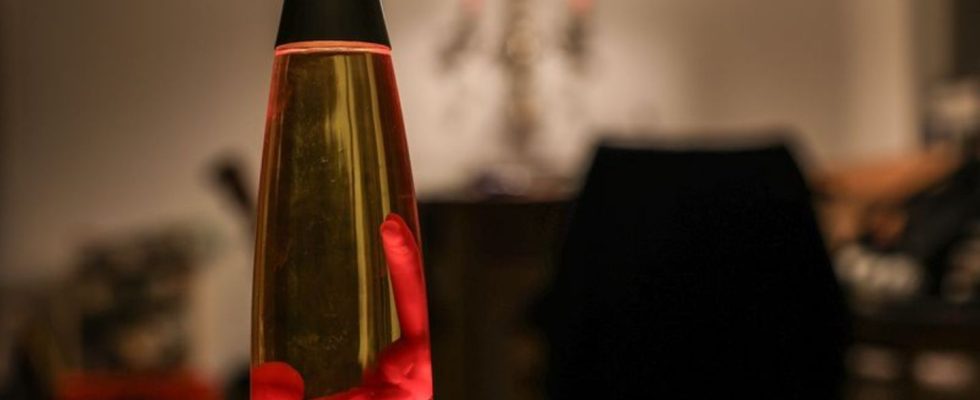The first lava lamp was created from the design of an egg timer. It came onto the market 60 years ago. Today the unusual lamp has cult status – and still has many fans.
Bubbles rise, slowly at first, then faster and faster. They bounce off each other and continue to tumble. Unite and share: you can lose yourself in the hypnotizing game of bubbles in a lava lamp.
Edward Craven Walker (1918-2000) advertised: “If you buy my lamp, you won’t need drugs.” He is the inventor of the lava lamp, which came onto the market 60 years ago – in 1963 – in the English town of Poole.
Edward Craven Walker’s company Mathmos still successfully sells the lights today. Even at flea markets, old models – originals as well as the many imitation products – still sell quickly. Perhaps this is also because the lights currently have a new appeal: they work very slowly in an age in which everything and everyone is connected and is always in a hurry.
“I like that lava lamps bring you down while they warm up,” says Cressida Granger, the current owner of Mathmos, to the German Press Agency. “You have to wait for all the bubbles. It’s a bit like a campfire. You have to stack it and light it first to be able to look into the flames.”
The beginning: Once upon a time there was an egg timer
Edward Craven Walker developed the first lava lamps in the early 1960s from the design of an egg timer that he saw in a pub, according to the Federal Association of German Patent Attorneys. Using a cocktail shaker on the stove with two liquids moving in it, measure the egg boil.
Craven Walker seized on this idea. For years he worked on prototypes of a lamp made from cocktail and orange juice bottles. There were two liquids in these that do not combine.
According to the Federal Association of German Patent Attorneys, the various lights on the market today usually contain a combination of wax or oil with isopropanol or ethylene glycol. If both liquids in the glass are heated by the waste heat from an incandescent or halogen lamp, the density of the wax-oil mass decreases more than that of the second liquid. The result: The wax becomes buoyant, bubbles form and rise. There they cool down and sink down again. And so forth.
Space design for the 60s
In 1963, the first lava lamp, “Astro,” came onto the market. The look was new and at the same time suited the changes of the time. Furniture as spacey as people imagined future travel in spaceships through space was popular. They had flowing shapes that seemed to break narrow boundaries.
This space age design peaked until the 1969 moon landing. Fittingly, the lava lights appeared during this time, among other things, in the futuristic BBC cult series “Doctor Who” – in the space-time machine “Tardis”.
At the same time, the waving, bright bubbles fit in with the pop art and vibe of the swinging 60s – and also with the new freedom in music, fashion and more in the 70s.
In the 80s: lava lamps were a flea market hit
After this peak period, lava lamps were virtually gone from the mass market. “It was different back then: you had to buy everything in the store, there was no internet,” says the current company owner, Cressida Granger. “So things were either ‘in’ back then or they were out. You found them in the stores or you didn’t find them.”
But at Granger’s vintage stall at Camden Market in London, lava lamps were still “selling like hot cakes – they were so popular,” she says. “For young people, lava lamps were now something very fresh.”
Sensing that there was great demand, Cressida Granger joined the inventor’s company in 1989 and gradually bought it up. And she gave the company a new name: in 1992, Crestworth became Mathmos. The term comes from the science fiction film “Barbarella” (1968) with Jane Fonda playing an astronaut. Mathmos is a seething lake in it.
Edward Craven Walker retired but remained a consultant for Mathmos. “He was in his 70s when we met, so he was an old man, but he still had so much energy and enthusiasm,” Granger says. “He flew helicopters. Or he bought a fire engine for his naturist camp in Dorset.” The inventor was considered an eccentric. He even made nudist films underwater.
The comeback – and the lava lamp as a random generator
In the late 90s and noughties, the lava lamp finally made Granger’s hoped-for comeback – albeit shared with countless copycat products on the market, especially from the Far East. In the following years, the competitive pressure on the technological side also increased: With color-changeable LEDs, everyone can now easily have a lighting installation at home.
“But there is one difference: the chaos,” says Cressida Granger. “It may take a long time with LED, but the patterns repeat themselves eventually. Not with lava lamps.” That’s why walls full of lava lights are still used to encrypt data, for example by the IT security provider Cloudflare.
Their inventor, Edward Craven Walker, died in 2000 – at a time when LEDs were slowly becoming commercially viable and could therefore become competitors. But he had a good prognosis for his bubble pattern back in the ’60s: “I think it will always be popular. It’s like the cycle of life. It grows, breaks, collapses and then starts again.”

